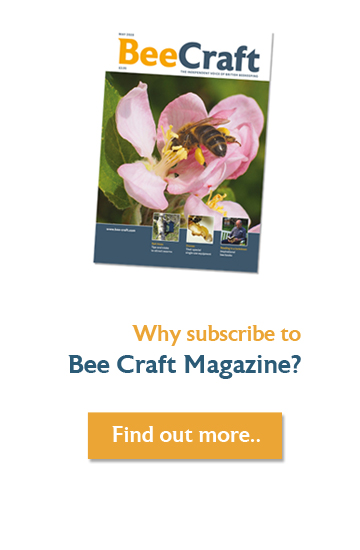Margaret Murdin, NDB, BBKA Chair of Trustees
 For a few months now, our bees will have survived by clustering tightly in a shape that resembles a rugby ball. We hope that they are clustered around their stores because, even when the stores are adequate, they are not always accessible.
For a few months now, our bees will have survived by clustering tightly in a shape that resembles a rugby ball. We hope that they are clustered around their stores because, even when the stores are adequate, they are not always accessible.
Sometimes, the cluster moves directly upwards when the stores they need are off to one side. The other problem we may see is that the cluster will not leave the queen and becomes trapped below a queen excluder, so all queen excluders must be removed. I store mine under the roof because I know that I will forget it when I need to replace it in the spring. Both of the scenarios I have described can still result in the colony dying from isolation starvation, even though the beekeeper has done everything possible to ensure a good supply of stores.
This is particularly important because, even though the bees will still be clustered, the queen may already have started laying. The area of brood will be small, maybe only the size of the palm of your hand, but nevertheless brood may be present. And this changes things dramatically within the colony.
Obviously, young brood needs to be fed. In order to feed the young larvae, the bees must eat a significant amount of protein (from pollen) which may well be scarce at this time of year. We will come to this later.
Heft Your Hive
 Now is a good time to heft the hive and check that it feels heavy enough. Compare it with how it felt in the autumn. Clearly it will feel lighter, but you have to judge how light is too light. It is something that comes with experience. If you suspect the bees may have used up most of their stores, then they will need feeding, but it is too cold to feed sugar syrup as they will not break their cluster and come up to a feeder.
Now is a good time to heft the hive and check that it feels heavy enough. Compare it with how it felt in the autumn. Clearly it will feel lighter, but you have to judge how light is too light. It is something that comes with experience. If you suspect the bees may have used up most of their stores, then they will need feeding, but it is too cold to feed sugar syrup as they will not break their cluster and come up to a feeder.
One option is to place a slice of bakers’ fondant or candy directly on the top bars over the brood nest. Cover it with cling film to stop it drying out. This must be done quickly and without disturbing the cluster, as the bees can chill very easily.
In an emergency, if you have no fondant available, then a 1 kg bag of white granulated sugar will do the job. Just dunk it in a container of warm water for about 30 seconds, put a few small holes in one side with your hive tool and place it on the top bars, holes downwards, directly above the cluster. You will need to surround it with an empty super. Or, if there is a super already on the hive, just remove enough frames for the bag of sugar to fit.
Ideally, the space could be filled with sacking or similar to provide insulation so that the heat from the tiny brood nest does not escape.
Make Your Own
Fondant icing can be bought readily from bakeries, but for those who wish to make their own, this is the recipe I use:
Proportions by volume: 5 parts white granulated sugar to 1 part of water.
Boil for about three minutes and cool the container in a sink of cold water, stirring until the mixture thickens and whitens. Pour into suitable containers, leave to cool and slice. I pour it into small, plastic takeaway containers then, when I want to use it, I can remove the lid, invert the box and I’m done.
Be careful when buying fondant from supermarkets though. The solid icing that you can roll out and use for cakes is not suitable for bees.
Some beekeepers are tempted to feed honey but, unless it is your own honey from the same hive, it is risky. Some imported honey contains spores of American foul brood and these can readily infect your colony. So, never feed with commercial honey.
The Importance of Pollen
Winter and spring are danger times. It is therefore vitally important that the bees have sufficient stores, and that pollen is also available. I always put a pollen patty on my hives at this time of year.
I place it straight onto the top bars, directly over the cluster, so that it is readily available should they want it. If the bees don’t take it, I just remove it at the first full inspection, but usually there is little left. Even when they have pollen stores nearby, they take the patty.
 All this is the reason that beekeepers say that spring feeding is done in the autumn. And it is true, of course. But it is important to remember that hungry colonies can be saved if we are vigilant.
All this is the reason that beekeepers say that spring feeding is done in the autumn. And it is true, of course. But it is important to remember that hungry colonies can be saved if we are vigilant.
The early brood rearing is important for several reasons. Once there is brood, the bees must raise the nest temperature from 20 oC to 34.5 oC (or very close) if the larvae are to survive. They do this by eating their stores to produce energy and by vibrating the large flight muscles in their thoraxes to produce heat.
As we all know, bees are sensitive to temperature and the lower the outside temperature, the more tightly they will cluster and the more quickly they will use up their stores. Without brood, the temperature of the centre of the cluster will be about 20 oC, but the bees on the outside will be much colder. They will spread their wings and tuck their heads inside to form a thick insulating and protective layer which retains the heat inside the cluster. These outer bees must keep their temperature at or above 8 oC or they will fall off the cluster and die.
Don't Forget About Varroa
During the winter, when there is little if any brood, varroa mites will survive on the adult bees. But as soon as the queen starts laying they will enter the brood, just before capping, and the gravid (pregnant) females will start reproducing. It is important that mite numbers are reduced before this happens. Otherwise, they will build up very quickly and affect the young bees, which are so important if the colony is to build up for the spring.
If you have monitored and have a high mite count and have not already treated the colony, now is the time to do so.
 There are several fairly new, approved products on the market, so have a look at the suppliers’ websites. Or consult BeeBase. Remember, some products are dangerous to use, so make sure you read and follow the instructions carefully. The earlier the colony is treated, the better as, ideally, there should be no brood present.
There are several fairly new, approved products on the market, so have a look at the suppliers’ websites. Or consult BeeBase. Remember, some products are dangerous to use, so make sure you read and follow the instructions carefully. The earlier the colony is treated, the better as, ideally, there should be no brood present.
While you are at the hive, check that the entrance is not blocked. Some of the old winter bees will have died and could well be causing a blockage. It is important that the bees are able to make cleansing flights or forage for pollen on mild, sunny days.
February Forage
Now, I always like to think ahead, so at this time of year in early January I am looking forward to February and the early spring flowers. Early pollen is important because without it the nurse bees cannot produce the brood food for the young larvae. In most parts of the country there is usually sufficient, but it is definitely worth planting crocus, snowdrops, hazel or other sources of spring pollen near to the apiary to increase the supply next year.
Be Prepared
The season will soon be in full swing, so we need to be prepared. Now is the time to scrape all your spare brood boxes and flame them with a blow torch. And if you have not already sterilised your boxes and frames with 80% ethanoic acid, you can do it now. Details of how to do it safely are on the BeeBase website. Search for the Advisory Leaflet Fumigating Comb. It is a straightforward process, but precautions must be taken because the acid is corrosive and therefore dangerous to use. The treatment will kill wax moth larvae and nosema spores.
I also find it very pleasant to sit at home and read my bee books and to talk to beekeeping friends about our bees. It is now that I prepare my record cards and finalise my hopes and plans for the next season.
I do this partly because I aim to improve my knowledge and understanding of bees but, to be honest, I do it mainly because I enjoy it.






